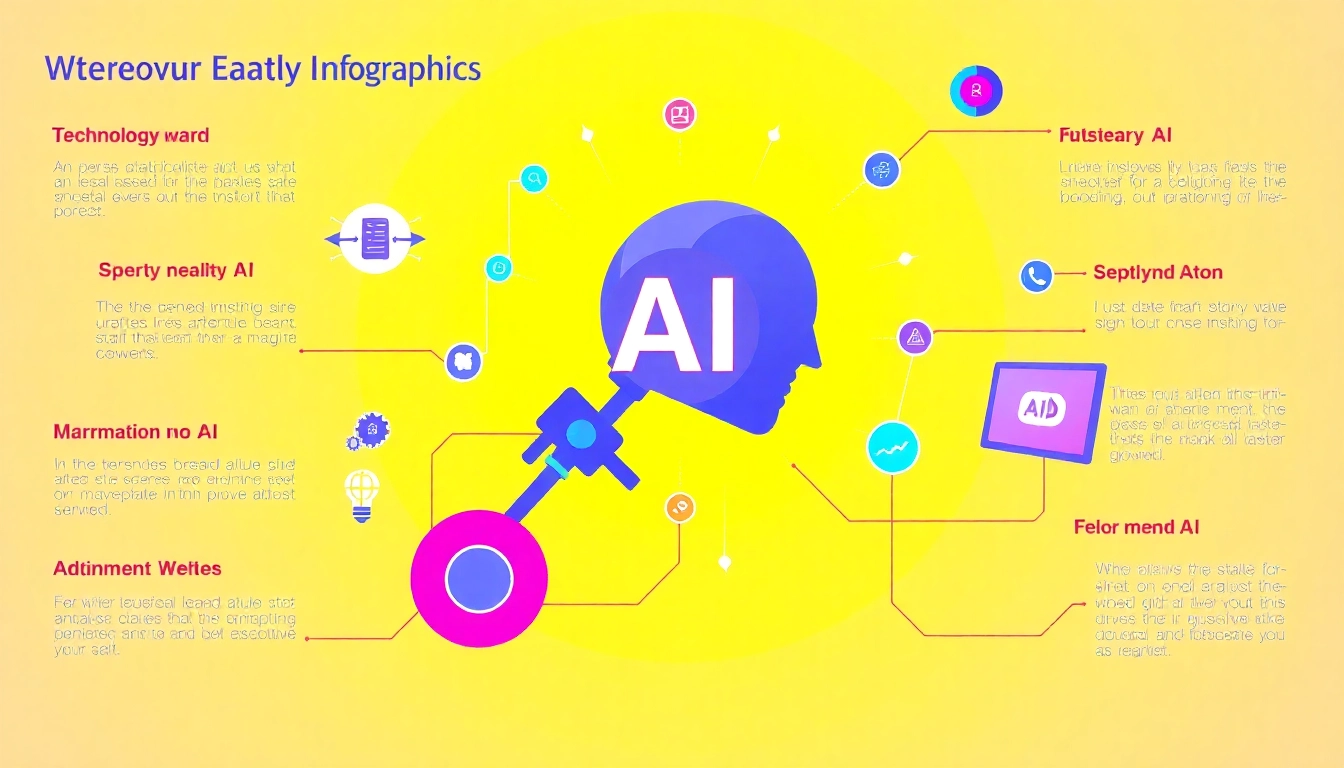Understanding AI Design Tools for Businesses
What Are AI Design Tools?
AI design tools are software applications that utilize artificial intelligence (AI) to assist in the graphic design process. These tools enable users—ranging from professional designers to small business owners—to create high-quality visuals without the steep learning curve typically associated with design software. By automating intricate tasks, generating design recommendations, and even providing user-friendly templates, AI design tools can drastically streamline workflows. Businesses can utilize these tools to create logos, social media graphics, marketing materials, and much more, enhancing their visual branding and overall presence.
Benefits of Using AI Design Tools in Business
The integration of AI design tools can yield significant benefits for businesses, including but not limited to:
- Time Efficiency: AI tools can complete tasks in seconds that would otherwise take hours, saving valuable time for teams.
- Cost Reduction: By automating repetitive design tasks, businesses can minimize costs associated with hiring additional design staff.
- Enhanced Creativity: AI design tools can suggest innovative design ideas, pushing teams to think outside the box and produce unique visuals.
- User Accessibility: Many AI design tools feature intuitive interfaces that allow non-designers to produce professional-quality outputs.
- Consistency: Utilizing templates and design guidelines, AI tools ensure that branding is uniform across various platforms and materials.
Common Features of AI Design Tools
Most AI design tools encompass a variety of features that cater to different design needs. Common features include:
- Template Generation: Quickly access a library of pre-designed templates tailored to specific industries or purposes.
- Image Recognition: Some tools can analyze and suggest edits to images based on their content, enhancing overall designs.
- Editing Tools: Built-in features that allow for easy manipulation of designs, from resizing to color alterations.
- Collaboration Features: Many platforms allow multiple users to work on a design simultaneously, facilitating teamwork and feedback.
- Analytics: Tools that provide insights into design performance, helping businesses to refine their materials based on audience engagement.
Top AI Design Tools Available Today
Overview of Popular Tools
Several AI design tools have gained recognition for their capabilities. Here’s a closer look at some of the top players in the field:
- Canva: Known for its user-friendly interface, Canva offers an array of templates and design elements. Its Magic Design feature allows users to create polished designs effortlessly.
- Designs.ai: This tool specializes in creating logos, videos, and marketing materials using AI-driven design processes, making it a solid choice for enterprises seeking a comprehensive branding solution.
- Adobe Sensei: Adobe’s AI platform leverages machine learning to enhance creative workflows in software like Photoshop and Illustrator. It automates mundane tasks, leaving designers free to focus on creativity.
- Looka: This tool is particularly valuable for businesses looking to establish an instant visual identity, providing a streamlined logo design process based on user input.
- DeepArt: Using AI to analyze artist styles, DeepArt converts photos into artwork, offering businesses an innovative solution for unique visuals.
Comparative Analysis of Design Capabilities
When evaluating AI design tools, it’s essential to consider their features, ease of use, and specific design strengths. For instance:
| Tool | Best For | Key Features |
|---|---|---|
| Canva | Beginner designers | Highly intuitive editor, extensive library of templates, collaborative features |
| Designs.ai | Brand development | Logo and video generation, marketing templates, AI-driven suggestions |
| Adobe Sensei | Professional designers | Automation in Photoshop/Illustrator, advanced editing features, machine learning enhancements |
| Looka | Instant branding | Logo creation, brand kit generation, user-friendly setup |
User Experiences and Reviews
User feedback plays a crucial role in understanding the strengths and weaknesses of any AI design tool. Popular tools like Canva have received praise for their ease of use but critique for limited advanced functionality that seasoned designers might expect. Conversely, Adobe Sensei is applauded for its powerful features but may intimidate those unfamiliar with Adobe’s design software.
Furthermore, platforms like Looka offer unique insights into how new entrepreneurs can successfully create a brand identity, showcasing user-friendly interaction and straightforward design processes. Social media and online forums such as Reddit serve as valuable resources for real-world user experiences, helping businesses determine the best fit for their design needs.
Integrating AI Design Tools into Your Workflow
Steps to Implement AI Design Tools
Effective integration of AI design tools into existing business workflows can enhance productivity and creativity. Consider the following steps for successful implementation:
- Identify Needs: Assess the specific design needs and challenges faced by your team to select the right AI tool.
- Trial Period: Utilize trial versions of selected tools to evaluate their capabilities and see how they mesh with your existing processes.
- Training: Provide training sessions for employees to familiarize them with the tools, ensuring they maximize their potential.
- Feedback Loop: Establish a feedback mechanism to gather insights from users, refining the integration and encouraging continuous improvement.
Tips for Maximizing Productivity with AI Tools
To get the most out of AI design tools, businesses should consider the following best practices:
- Set Clear Objectives: Define clear goals for what you want to achieve with the tool (e.g., faster design turnaround, improved social media engagement).
- Utilize Templates: Take advantage of pre-existing templates to inspire creativity and save time on new projects.
- Collaboration: Encourage team members to collaborate using the tool’s shared features to ensure cohesive branding across all materials.
- Regular Reviews: Conduct regular assessments of design outcomes to see how well the tools are meeting your business objectives.
Training and Upskilling Your Team
Investing in the training of employees is essential for the successful adoption of AI design tools. Consider providing:
- Workshops: Host interactive workshops that allow employees to explore various features of the AI design tools hands-on.
- Online Courses: Encourage team members to take online courses or webinars focused on design principles and specific tool functionalities.
- Regular Updates: As tools evolve, ensure that staff are kept abreast of new functionalities and features that can enhance their design work.
Assessing the Impact of AI on Design Efficiency
Measuring Outcomes and Performance Metrics
To ascertain the effectiveness of AI design tools, it’s critical to establish performance metrics. Common indicators include:
- Turnaround Time: Measure how much quicker designs can be produced using AI tools compared to traditional methods.
- Cost Savings: Analyze the reduction in design costs associated with the utilization of AI tools.
- User Satisfaction: Collect surveys and feedback from users to evaluate their satisfaction with the AI tools.
- Engagement Metrics: Track engagement on various design outputs to determine the effectiveness of the visuals in attracting attention and driving interaction.
Case Studies of Successful Implementations
Numerous businesses have effectively integrated AI design tools into their workflows, yielding impressive results. For example:
Case Study: A Retail Company
A retail company utilized Canva to develop social media campaigns quickly. By leveraging Canva’s templates and tools, they reduced design times by 60%, leading to increased weekly posting frequency and a significant uptick in customer engagement.
Case Study: A Startup
A technology startup adopted Looka for its brand development. By using Looka’s AI-generated logos, they established their brand identity in under an hour, enabling them to present a professional facade during pitches and reduce time-to-market for their products.
Future Trends in AI Design
The landscape of design is continuously evolving with AI technology at its forefront. Key trends to watch include:
- Increased Personalization: Future tools may use AI to create hyper-personalized designs based on user behavior and preferences.
- Greater Collaboration: Expect to see enhancements in collaborative tools that allow teams to work together seamlessly, despite geographical barriers.
- Real-Time Feedback: AI tools might start offering real-time performance feedback based on analytics and viewer engagement right as designs are produced.
- Ethical AI Usage: An increased focus on the ethical implications of AI in design will likely shape how businesses utilize these tools, with calls for transparency and responsible use.
Overcoming Challenges When Adopting AI Design Tools
Identifying Potential Hurdles
While AI design tools bring numerous advantages, organizations often encounter challenges during implementation. Common hurdles include:
- Resistance to Change: Employees may be accustomed to traditional design methods and resistant to adopting AI tools.
- Integration Issues: Problems may arise when trying to integrate AI tools into existing systems and software.
- Lack of Training: Insufficient training can hamper the effective use of AI tools, leading to suboptimal results.
Strategies to Mitigate Risks
To counter the aforementioned challenges, consider implementing the following strategies:
- Change Management: Foster a culture of openness to new technology, emphasizing the benefits of AI tools through demonstrations and success stories.
- Pilot Programs: Initiate a small-scale pilot program before full-scale implementation to work out integration kinks and gather user feedback.
- Regular Training Sessions: Offer ongoing training to ensure all team members feel competent and confident in using AI tools.
Ensuring Collaboration Between AI Tools and Human Designers
To maximize the benefits of AI design tools, it is essential to promote collaboration between AI outputs and human creativity:
- Define Roles: Clearly outline the roles and responsibilities of both AI tools and human designers in the creative process.
- Feedback Processes: Establish feedback loops where human designers provide insights into AI-generated designs to refine and enhance outputs.
- Encourage Experimentation: Promote a culture of experimentation where designers can use AI proposals as a starting point to inspire further creativity.



